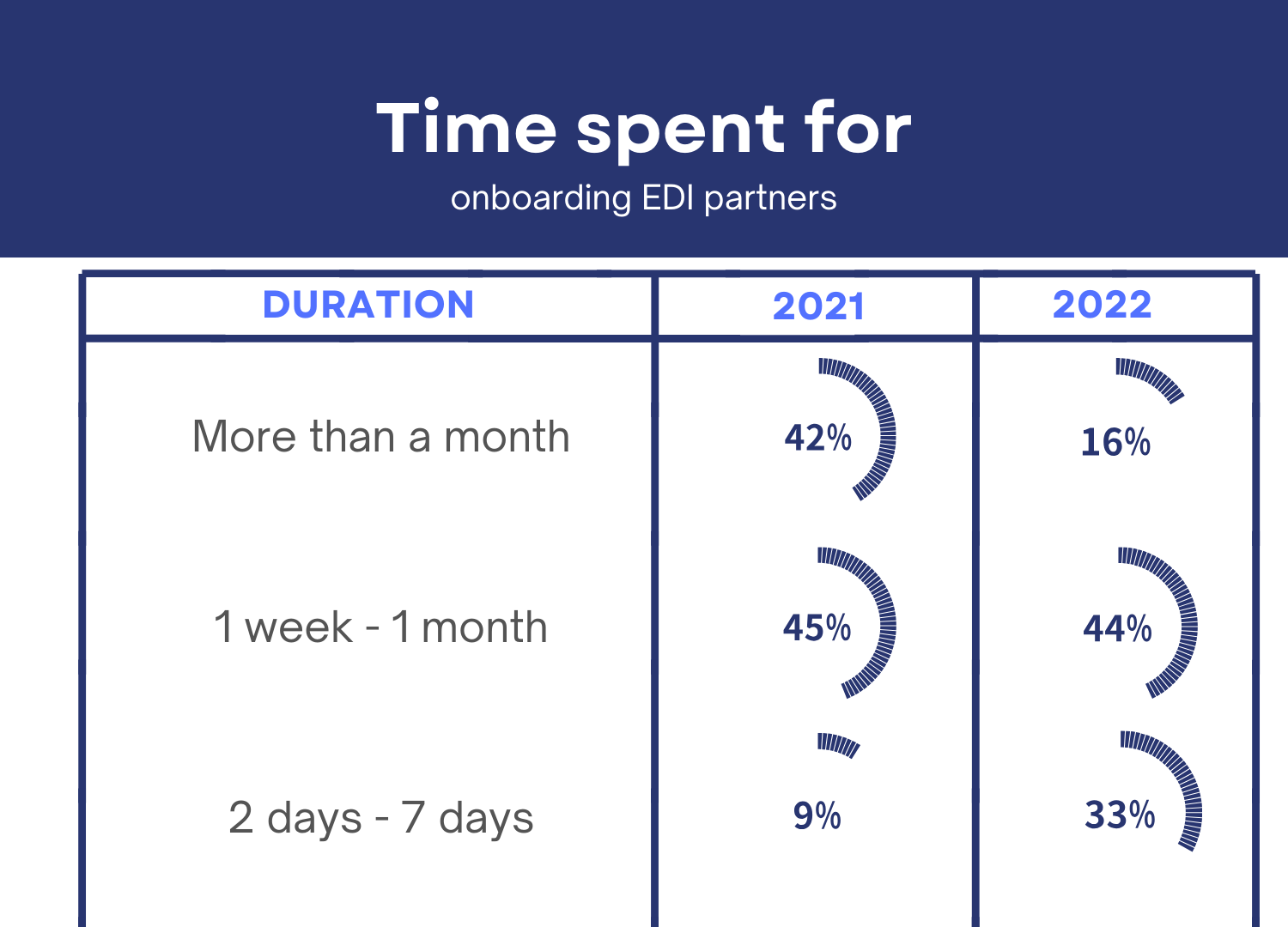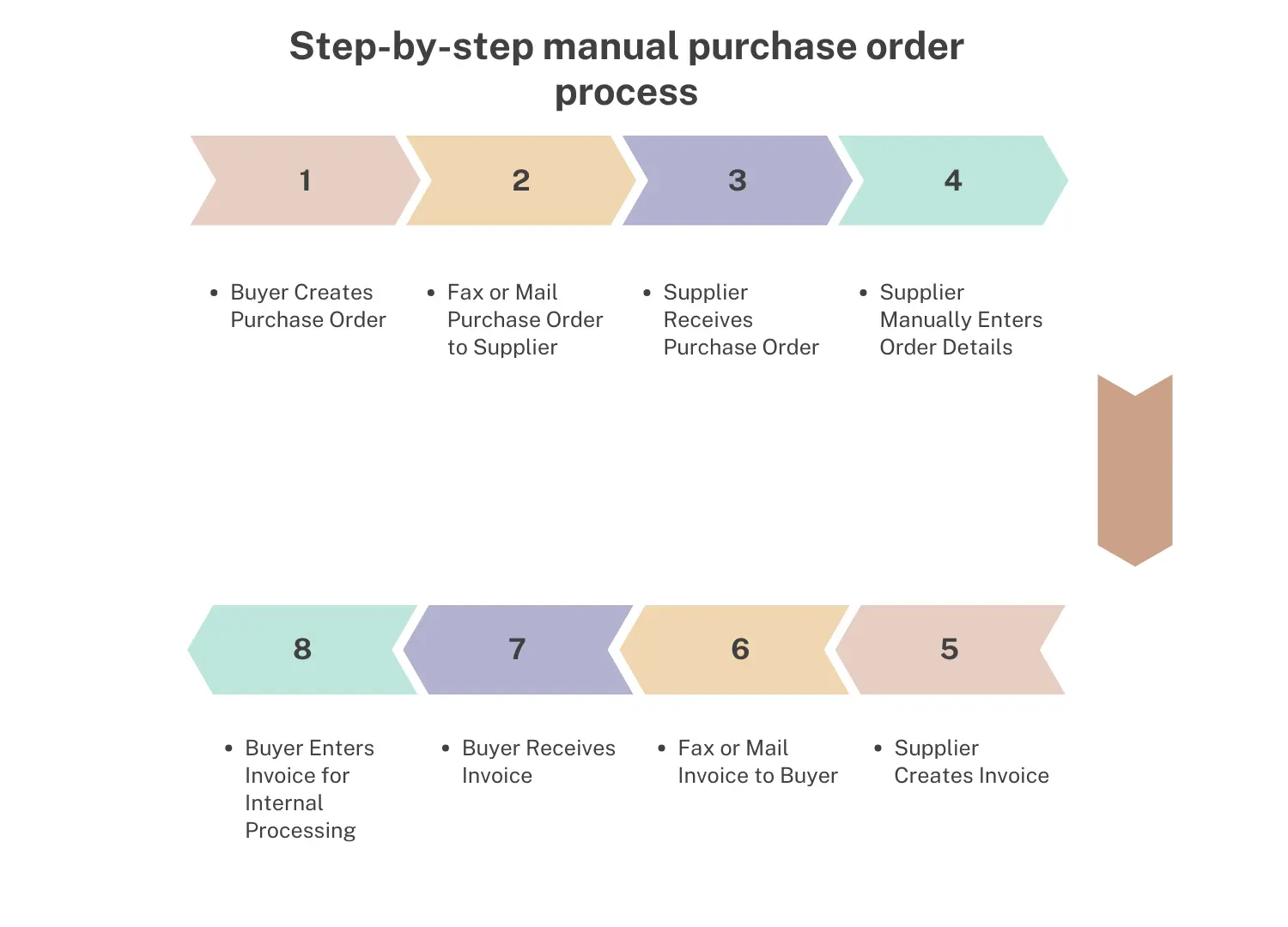Table of Contents
In the quickly changing business environment, establishing solid, effective, and transparent trading partnerships is more important than ever. In the digital age, organizations aim to increase growth, enhance collaboration, and optimize their operations. However, according to data, 53% of businesses find it difficult to quickly integrate trading partners with their current B2B connectivity solutions. The report also shows that almost 40% of businesses need more than 30 days to onboard a new trading partner. As a result, this impacts the company’s operations. In an ever-changing environment, Electronic Data Interchange is essential. Through its role as a digital link, EDI transforms partner transactions by providing a safe and uniform means of exchanging documents. It fosters strong alliances, expedites communication, and makes EDI onboarding of partners easier. Electronic data interchange solutions are changing the way businesses operate. It is streamlining operations, cutting down on mistakes, and raising productivity levels.
However, EDI onboarding can be a little complicated. Luckily Some cutting-edge integration platforms and service providers can onboard your clients up to four times quicker than their rivals. As a result, new clients can get up and running in a matter of hours as opposed to days or weeks of onboarding. Even more control over business schedules and operations is possible with certain platforms’ user-friendly self-service solutions. This implies businesses don’t need to rely on outside assistance—they may use the platform themselves and onboard clients internally. The most flexible choice is offered by the less popular but highly sought-after hybrid option, which blends self-service and managed services.
It would be helpful to first comprehend the present state of B2B integration technologies to choose which integration platform will assist your company in integrating EDI partners more quickly and improve your bottom line. The rapid changes in the field, aiming to keep pace with the evolving digital landscape, might surprise you
EDI’s Growing Significance in Business Partnerships
EDI has grown in corporate partnerships and is now an important part of it. It is because of its capacity to transform productivity, provide real-time worldwide communication, save costs, guarantee data correctness, support compliance, and ease partner onboarding. Removing geographical obstacles allows for quick and dependable information exchange. It enables firms to act more swiftly and efficiently in response to market demands.
EDI fosters confidence and dependability amongst EDI trading partners by lowering manual processes, avoiding errors, and encouraging consistent data sharing, guaranteeing a smooth onboarding process. It also assists businesses in adhering to regulations, cutting expenses, and implementing sustainable practices like paperless operations and decreased carbon footprints. It ultimately results in a more ecologically friendly strategy. The smooth integration and synchronization of data made possible by the integration of EDI services with current business applications enhances supply chain management, inventory control, and forecasting accuracy.
Schedule a Free Consultation Today and Get Started With Your EDI Project
Using EDI to Improve Partner Relationships
Using Electronic Data Interchange, organizations can communicate with their trading partners. This is an automatic and standard manner. By encouraging better communication amongst corporate partners, EDI implementation fosters a more cooperative mindset. Let’s examine some of the main advantages of using EDI to build stronger company ties:
1) Instantaneous Data Sharing for Better Decision Making
Businesses may get real-time sales, demand, and inventory updates because EDI facilitates real-time data interchange. This facilitates the ability to make well-informed decisions, exhibit agility, and seize new chances. EDI services are essential for proactive adaptation and maintaining a competitive edge in rapidly evolving industries like electronics and fashion, where quick access to reliable information is critical.
For example, a supplier may send an EDI message to a clothes retailer promoting a particular region’s preferred shirt style. This reduces dependency on labor-intensive manual reports that take time to compile and evaluate. Businesses can allow the shop to rapidly adjust inventory and marketing plans to capitalize on the trend.
2) Standardization Promotes Efficiency
Businesses can reduce the risk of errors, miscommunication, and compliance difficulties by switching to EDI from manual operations. In addition, Electronic Data Interchange facilitates quick decision-making and standardizes data and communication. It accelerates the business cycle, builds confidence, and fosters positive relationships with partners.
For example, manufacturers typically send purchase orders by fax or email to their suppliers. This might lead to errors, such as the wrong product codes or quantities, which can delay production. Standardized purchase orders are issued after implementing EDI, which speeds up the process and lowers error rates.
3) Building Business Relationships on Transparency and Trust
Transparency and trust are essential for building strong working relationships with commercial partners. EDI communication protocols improve relationships between companies and partners by facilitating consistent, safe, and transparent communication by doing away with manual processes and standardizing partner communication.
For example, a merchant that sources goods from several vendors finds it difficult to use manual processes to track order status and guarantee on-time delivery. Real-time order tracking is made possible via EDI integration, giving supply chain visibility. This enables the company to instantly inform customers of any problems or delays.
4) Improved Scalability and Prospects for Business Growth
The intricacy of handling EDI transactions and sharing data might rise as companies grow and interact with more EDI trading partners. A standardized and automated method that can easily manage higher transaction volumes and adjust to shifting market demands is provided by EDI. This makes it possible for companies to grow their partner network. They can penetrate new markets, and react swiftly to new opportunities.
For example, a fashion e-commerce platform can use EDI, especially to expedite order fulfillment and inventory management. It can manage more orders, track inventories in real time, and synchronize product availability across channels by automating information exchange with partners. This optimized strategy boosts development potential in a variety of marketplaces, improves customer happiness, and permits scalable operations.
5) Lower Transaction Expenses
EDI trading partners can save a lot of money by implementing EDI. Partners can cut transaction costs related to printing, mailing, and human data entry by switching from paper-based transactions to electronic exchanges. Trading partners can concentrate on their core business operations and manage resources more effectively. It eventually results in cost savings and increased profitability.

With EDI, for instance, two shops can cut costs by doing away with the need to print and ship purchase orders, invoices, and payment checks. This results in a reduction in transaction costs and freeing up funds for other important corporate initiatives.
Onboarding Process for EDI Partners
Several crucial procedures must be followed for the onboarding of new trading partners in an EDI system to be effective. To guarantee a seamless EDI integration, the subsequent six stages are commonly observed:
1) Determining the Needs and Requirements of Partners
The company must first determine the precise EDI needs and requirements of the new trading partner. Finding out about their communication protocols, security needs, supported file formats, and any other important details is part of this. To customize the EDI solutions appropriately, variables like partner organization complexity and industry requirements are taken into account.
2) Opening Lines of Communication
Setting up transparent channels and procedures for communication is the next stage after determining the partner’s requirements. This entails deciding on the best means of communication, such as email, FTP, or AS2. Also, make sure that both sides have the software and hardware setup to enable simple data transmission.
3) Adapting EDI Products for Interaction
After establishing communication channels and gaining a thorough understanding of the partner’s demands, the company goes on to customize the EDI solutions for seamless integration. This step calls for the development of EDI mappings that specify the mapping of data items from the organization’s system to corresponding elements in the partner’s system. Furthermore, specialist tools might be used for data translation and mapping to guarantee precise data interpretation and exchange.
4) Consent and Records
The company and the trading partner must have a legal contract to formalize the onboarding process. The expectations, duties, and responsibilities of each are set in this document. It addresses topics like ownership of data, service level agreements, data security, and dispute resolution procedures. Clear communication is established through EDI communication protocols, which also act as a point of reference for upcoming exchanges.
5) Testing, debugging, and Training
To guarantee correct functionality, this stage entails extensively testing, debugging, and modeling real-world scenarios of the EDI connection. The EDI trade partner also receives training sessions to help them use the EDI system efficiently and to give technical support as needed.
6) Observation and Ongoing Enhancement
Following the completion of the EDI onboarding process, the company sets up monitoring systems to keep tabs on the effectiveness of the modern EDI system and pinpoint areas for improvement. To guarantee seamless operations, the tracking of data flows, error rates and reaction times is necessary. To enhance the efficiency of the EDI process, teams ensure ongoing evaluations and maintain consistent communication with the trading partners.
By taking these actions, businesses may create reliable and effective EDI services and expedite the onboarding of new EDI trading partners.
Reducing Your OnBoarding Time by 80% With Our Streamlined EDI Process
Supplier EDI Onboarding – The 7 Key Steps
Step 1: Establish the EDI requirements & Start The Process
Naturally, the first stage in any supplier onboarding endeavor is for your provider to pinpoint your particular needs. The project will move more quickly and efficiently if you and your EDI supplier have a clear point of contact. However, there is no one right way to accomplish this.
Following the agreement with your internal team, your EDI provider will communicate with them to ascertain your needs. This entails talking about:
Procedures: How are purchases, shipping, and billing managed?
Document kinds:
Which types of documents must be realized? For instance, are you primarily interested in trading invoices, or are you also interested in exchanging other frequently used document kinds, including orders and dispatch advices (also known as 810, 850, and 856 for X12 messages, and as INVOIC, ORDER, and DESADV for EDIFACT messages). Additionally, automated transmission of inventory reports (INVRPT / 846), sales data reports (SLSRPT / 818), and receiving advice messages (RECADV / 861) will be made possible by more advanced EDI services.
Which data pieces should be provided in every message, according to the message data granularity? Do you need further details, like descriptions or best-before dates, in addition to the fundamentals (price, quantity, and piece number)?
The semantics of messages and processes:
How are your exchange messages structured and what is in them? The ERP system typically has a preferred structure for data interchange (data model). To create the data mapping, the EDI solution providers must be informed of this.
Message protocols: How does your back-end system communicate EDI data with you? Several protocols can be used to do this, including SFTP, HTTPS, and API.
Because this procedure is unique, it is difficult to forecast how long it will take. However, if a dedicated project leader is appointed internally and knows about the requirements, this stage can be completed in a few days. But in reality, the procedure usually takes longer and requires a good deal of back and forth.
Step 2: Message Implementation Guide (MIG) creation
Your EDI solution providers will develop your message implementation guide (or MIG) after the fact-finding phase is finished. A MIG essentially serves as a “how to” manual for your partners, outlining the precise EDI requirements for your company as well as your preferred message formats, among other things. Each MIG typically requires two days of work to finish.
This step must be finished properly because its success affects the other steps in the EDI onboarding process. To guarantee the dependability of the MIG, fully managed EDI suppliers will test messages on your system. They might even ask one of your close suppliers to assist them in running a parallel phase to make sure everything is working as it should. Your only task is to review the messages and indicate anything that needs to be changed.
Unfortunately, managers often rush this stage with poorly managed EDI systems, and they perform little to no testing, which might lead to mistakes later on.
Step 3: Establishing an online EDI platform
You could also want to use Web EDI to link suppliers who lack EDI capabilities if you want to automate as much of the document interchange in your supply chain as possible (for more details on Web EDI and its advantages, view our white paper). If so, the range of message types that are used with suppliers via “classic” integrated EDI and the scope of your Web EDI platform must align. For instance, in addition to orders, dispatch advice, and invoices, you could need to exchange non-mainstream documents like SLSRPT, INVRPT, or RECADV. In this scenario, it’s important to choose an EDI provider, that can handle this (because this feature is uncommon).
The development of your Web EDI platform will occur concurrently with the formation of your MIG(s). The EDI solution will be connected to your ERP system once, and the platform will then be configured to your specifications. By your MIG, your supplier should be able to deliver test documents via the platform (for you to then check). Similar to how the MIG was established, you would want to involve a close supplier in the platform’s testing before a wider distribution.
Platforms are not always very popular with suppliers because Web EDI needs them to perform manual work before you can enjoy complete automation. Therefore, you may significantly boost uptake throughout your supply chain by choosing a Web EDI system—like a Web EDI solution—EDI experts can minimize work on the part of your suppliers by offering capabilities like batch support, PDF printing, and semi-automated document preparation.
Step 4: Set priorities and talk to your partners
After the creation of your MIG and Web EDI platform, it’s time to start partner onboarding. With your EDI supplier, though, you should first agree on a plan of action before addressing them. EDI onboarding partners may take some time in large supply networks. Thus, to get the most out of your new system, it makes logical sense to give particular partners’ onboarding priority. For instance, you could want to give your nearest or largest suppliers priority. Given their extensive experience with such projects, your EDI consultant ought to be able to provide insightful advice in this regard.
Following the agreement on the supplier EDI onboarding strategy, your provider should speak with each supplier to get clarification on several issues, including identifiers (like the GLN number), current capabilities (like the kinds of documents they can exchange via EDI), and preferred connection types (like AS2, X.400, VAN, etc.).
Your EDI provider should also inform your suppliers of your new message rules during this process so they can understand what your system needs and how to produce legitimate outgoing documents.
Step 5: Validation and testing of message exchange
During the EDI testing and Validation phase, your supplier receives papers from your EDI service provider, and your provider responds with the required information (e.g. an Order and Order Response). Your provider should let them know what went wrong so that it may be fixed. We call this validation.
One manual method of validation is to compare the message with the MIG. But this is a laborious and prone-to-error procedure. Rather, validation is best managed semi-automatically by using third-party software that can check message syntax, or automatically by using the integration program’s built-in validation checks.
Error reports from automated checks, like the ones carried out by cloud-based EDI solutions, can be sent to the document issuer right away via email or online portal. However, manual inspections require a lot more work, which extends the time it takes to prepare the error report.
Your internal team will review the communication after any errors have been fixed and your supplier has responded in a way that complies with your MIG. If you choose a fully managed provider, this should be the extent of your input needed.
Step 6: Launch the product
The connection can go live if you are satisfied with your supplier’s reply. In certain situations, you might want to continue your prior message exchange approach while implementing a parallel phase for a few months to make sure everything is running smoothly.
The process is considerably more straightforward when EDI vendors are connected via Web EDI because all they need to do is activate their account on the platform. It might not even be necessary to provide training if your Web EDI portal is sufficiently intuitive and user-friendly. An alternative is to offer it as pre-recorded movies or documentation.
Step 7: After the launch
Although the EDI onboarding process may come to a close with go-live, there is still much work to be done in terms of continuing document exchange with your partners. To guarantee that message details meet your MIG’s criteria, for instance, your supplier might carry out regular validation mapping checks. This would help you prevent the problems that arise from sending inaccurate details to your ERP.
Processes for message monitoring and error management must also be in place for the system to be successful and future-proof. Importantly, going live for many systems means that your EDI partner is no longer actively involved, thus internal teams are left to handle these duties. This isn’t the case, though, if a fully managed EDI solution provider is chosen.
Ideally, your EDI provider will still manage the EDI connections for your company, serving as a point of contact for your suppliers (both web and classic EDI users) and taking proactive steps to fix problems and guarantee connections are operating as efficiently as possible. In this manner, you gain from less strain on internal teams, which saves time and money, as well as more dependable EDI.

EDI Onboarding Checklist
Ensures Compliance
An EDI onboarding checklist ensures adherence to rules and industry standards. This is one of the main reasons why it’s essential. EDI standards give organizations a common language to communicate and share data. This includes ANSI X12 and EDIFACT. A well-designed onboarding checklist will lead your company through the processes required to follow these guidelines. Also, it will lower the possibility of expensive mistakes or non-compliance problems. Additionally, with the integration of cutting-edge technologies like punchout platforms and APIs, a checklist eliminates the risk of missing out on important things.
Promotes a Smooth Transition
For businesses that have relied on manual processes, switching to an EDI system can be a difficult and intimidating undertaking. An EDI onboarding checklist acts as a road map, dividing the procedure into doable phases like granting Trading Partner contact details and specifications and granting RDP or VPN access to your environment. This reduces the stress of missing important duties, resulting in a more seamless transition.
Cuts Expenses and Mistakes
Errors can occur when entering data by hand. This can have expensive repercussions for enterprises. Think about the 1-10-100 rule. You should budget $10 to fix a mistake for every $1 made, and $100 if the mistake causes a failure. By promoting automation and removing the need for human data entry, an EDI onboarding checklist lowers the likelihood of costly errors. Automation increases efficiency, which lowers labor and operating costs and results in cost savings.
Boosts Speed and Efficiency
In the commercial sector, time is of the essence. Businesses may share information instantly because of EDI’s process streamlining capabilities. Businesses may optimize system performance and ensure fast and flawless data flow between EDI trading partners by using an onboarding checklist. This increased speed can have a big impact on order processing and supply chain management.
Enhances the Accuracy of Data
Misinformation can cause misunderstandings and arguments among business associates. Data validation and quality control procedures are highlighted in an EDI onboarding checklist, from an EDI perspective as well as a business rule perspective. This lowers the possibility of disagreements and promotes trust between partners by guaranteeing the accuracy of the data conveyed.
Enhances Boundary Advantage
EDI integration might give your company a competitive advantage in your sector. It improves efficiency, lowers expenses, and streamlines processes. Using an onboarding checklist helps you take advantage of these benefits. It streamlines the integration process.
Encourages More Robust Collaborations
Both your company and your trading partners will benefit from a well-organized EDI onboarding checklist. It proves your dedication to smooth cooperation and efficient communication. Small details that can differentiate you from the competition in the eyes of your clients include branding on a Bill of Lading or accurate information on carton labels. By streamlining the EDI onboarding process as much as possible, you improve connections with your partners and foster trust.
Are You Switching to EDI? Want Help to Ensure a Smooth Transition?
Conclusion
Since every business has a unique set of circumstances, including size, structure, and internal or external platforms, every fast-track EDI onboarding solution should also be unique.
Some of the methods and tools your business can utilize internally to reduce EDI onboarding time are as follows. Other options include locating EDI service providers in the USA whose onboarding services meet the particular requirements of your company.
Automation technologies, for instance, can assist your company to reduce EDI onboarding time and take charge of the onboarding process. With the aid of business process automation solutions, your staff may do laborious and time-consuming tasks more quickly and effectively by processing data for EDI testing and Validation without requiring human involvement.
By managing the most difficult and time-consuming activities, an EDI services provider may assist you with quick EDI onboarding. This will free up the time and resources of your IT department, ultimately saving you both money and time.
By hiring EDI support specialists, you may improve and develop your onboarding policies and give your EDI implementation challenges like rigidity to knowledgeable professionals while your business concentrates on more important activities. Managing supplier compliance can be easily handled by an experienced EDI provider!
FAQs
What is the procedure for EDI onboarding?
The moment a new vendor receives a contract, the EDI onboarding process gets underway. Since both parties have decided to use EDI to transmit business documents, consider a few things before the start of trade.
What is the procedure for integrating EDI?
EDI integration is the process of establishing an entire EDI workflow between trading partners. It addresses various important topics, such as Partners in trade i.e. who are you using EDI to exchange business papers with? This may sound simple, but it’s important.
An EDI trading partner: what is it?
All you have to do is exchange papers with another company to become an EDI business partner. The majority of OEMs have a sizable network of business associates, which are also known as “Trading Communities.”
EDI Tools: What Are They?
EDI tools electronically automate routine business activities that occur between your firm and your clients or business partners.
Does EDI have an API?
Businesses can exchange digital documents in a standard format with their partners by using Electronic Data Interchanges (EDIs). Software programs can connect with one other more easily thanks to Application Programming Interfaces (APIs), which provide precise instructions.






